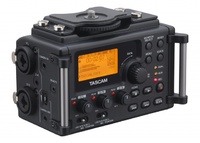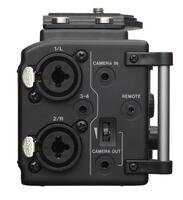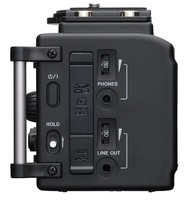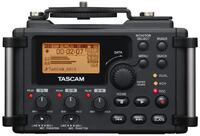 I recently acquired one of the new TASCAM DR-60d portable digital recorders for DSLR and video production. Lately, Teac TASCAM (now owned by Gibson guitars) has been slow in coming out with fresh products that are new solutions to old problems (their 8+2 multi-track field recorder was their last major innovation) -- but I believe that they hit the nail on the head with this new recorder.
I recently acquired one of the new TASCAM DR-60d portable digital recorders for DSLR and video production. Lately, Teac TASCAM (now owned by Gibson guitars) has been slow in coming out with fresh products that are new solutions to old problems (their 8+2 multi-track field recorder was their last major innovation) -- but I believe that they hit the nail on the head with this new recorder.
To begin with, the DR-60d resembles a "motor drive" of old, and is designed to mount directly under the body of a DSLR camera. There is no question what this recorder is intended for. It is the audio module that your camera manufacturer never bothered to include!
Personally, I have never been a fan of using DSLR for video production (except to take production STILLS). They are still cameras, and do a mighty fine job at it. But they are NOT video production cameras, in spite of being able to shoot some bursts of video. Heck, my cell phone can shoot bursts of video, but I do not consider it to be a production video camera either!
But people like them. And if you tech out the good DSLR's with several thousand dollars of accessories, such as shoulder mounts, follow focus, video monitors, external hard drives, and audio stuff -- you can modify them to the point of practical usefulness! (Although the shutters still work differently, which affects the overall look.)
Of course, by the time you spend all this money -- you could have just gone out an gotten yourself a very fine video camera, even a RED!
Please don't bother to email me with your counter arguments. I know that many people adore their DSLR's and praise the rediscovery of controlled depth of field.
So that leaves us back to the DR-60d, which is intended to address at least the audio issue with DSLR.
TASCAM offers us a completely portable four-track audio recorder that lists for only $399 (and streets around $350). The unit can be used with a DSLR, or functions just fine as a stand alone recorder.
Digital recording format of WAV or BWF (broadcast wave file), 16 bit or 24 bit, 48 K.
 Inputs 1 & 2 are XLR combination jacks that accept XLR or 1/4-inch, mic level or line level. 48v Phantom is available in the XLR's.
Inputs 1 & 2 are XLR combination jacks that accept XLR or 1/4-inch, mic level or line level. 48v Phantom is available in the XLR's.
The secondary input (3 & 4) is a stereo mini jack, which is mic level only. Although the input is a stereo jack, it is a simple solution to acquire an adapter cable to convert from a single stereo mini to a pair of XLR inputs. I recommend strain relieving your adapter cable to the rugged strap lug, so that it does not accidently jiggle loose.
There are menu choices for general input sensitivity range (low, mid, high) as well as three pots for: 1, 2, and 3/4.
Recording options include: mono input, attenuated dual mono (an attenuated safety copy of the mono track is recorded simultaneously), stereo or 2-track, attenuated dual stereo (an attenuated safety copy of the stereo track is simultaneously recorded), and four-track mono (four discreet input tracks). Those are a lot of options, but all of them make good sense. If you have four tracks at your disposal, you might as well utilize them either as four inputs or two tracks with an attenuated safety copy.
It is extremely useful to record an attenuated copy of your tracks. In the event of clipping, the editor only needs to cut to the attenuated version of the recording.
While you are recording onto the TASCAM, you can route a stereo mini mic level output up to the camera body. In addition, you can even take an audio monitor feed from the DSLR and bring it into the headphone monitoring bus of the DR-60d.
The DR-60d has a built-in monitor mixing bus that allows you to listen to whatever suits your needs. You can select to mixdown the tracks, or to monitor selectively, or to listen to the audio return from the camera.
To assist in syncing the double system audio of the DR-60d with the in-camera scratch track, the TASCAM has a bulit-in tone slate. With the press of a button, you can record a tone burst on both the DR-60d and the DSLR. Or, you can opt to automate the process, and the four-track will output a tone burst every time you start recording. You even can select the option to generate head AND tail slating tones (my preference for editing).
In adition to the automated head & tail tones, I sometimes still add a cadence of manual beeps at the beginning, to quickly eyeball matching takes in the edit bay.
The DR-60d does not generate timecode, but you can do just fine without it. Between having the slate tones, or using Plural Eyes software -- you should have no difficulty at all in syncing up your takes.
The menu is simple to learn and to use. Read the manual, and then play with it a little bit -- and it all becomes very intuitive. Essentially, you press MENU, scroll to your selection, hit enter to access your dropdown options, and enter to accept. The fast forward button works like a tab button, to advance the cursor. Back out by pressing the MENU button. It sounds way more complicated than it actually is, and you will get into the rythm very easily.
 The TASCAM DR-60d powers from AA batteries, and records onto SDHC card. It comes with an USB cable, but I generally prefer to just remove the card and transfer directly to my computer.
The TASCAM DR-60d powers from AA batteries, and records onto SDHC card. It comes with an USB cable, but I generally prefer to just remove the card and transfer directly to my computer.
Conclusion
The TASCAM DR-60d is an excellent product and offers better features than other competing four-track (non-timecode) recorders. The underbody ergonomics, flexible safety tracks, tone generator, and monitor mix capabilities are features that make this product stand out from the other brands. I like it.
